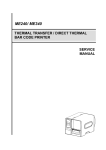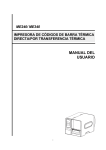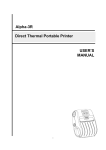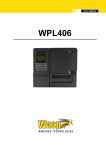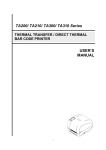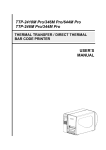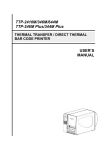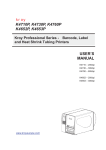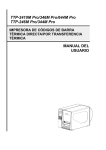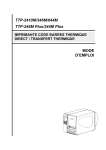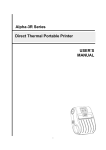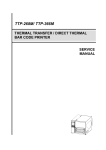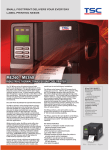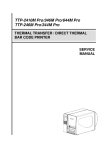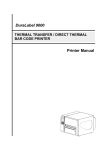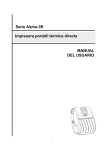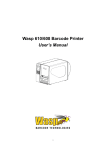Download USER`S MANUAL ME240/ ME340
Transcript
ME240/ ME340 THERMAL TRANSFER / DIRECT THERMAL BAR CODE PRINTER USER’S MANUAL i Copyright Information © 2011 TSC Auto ID Technology Co., Ltd, The copyright in this manual, the software and firmware in the printer described therein are owned by TSC Auto ID Technology Co., Ltd, All rights reserved. CG Triumvirate is a trademark of Agfa Corporation. CG Triumvirate Bold Condensed font is under license from the Monotype Corporation. Windows is a registered trademark of Microsoft Corporation. All other trademarks are the property of their respective owners. Information in this document is subject to change without notice and does not represent a commitment on the part of TSC Auto ID Technology Co. No part of this manual may be reproduced or transmitted in any form or by any means, for any purpose other than the purchaser’s personal use, without the expressed written permission of TSC Auto ID Technology Co. ii Agency Compliance and Approvals CE CLASS A EN 55022:2006 +A1:2007 EN 55024:1998+A1:2001+A2:2003 EN 61000-4 SERIES REQULATIONS FCC CFR Title 47 Part 15 Subpart B:2009-Section 15.107 and 15.109 ICES-003 Issue 4:2004 Class A AS/NZS CISPR 22:2009 CLASS A GB4953-2001 GB9254-2008 (CLASS A) GB17625.1-2003 此为 A 级产品,在生活环境中,该产品可能会造成无线电干扰,在这种 情况下,可能需要用户对干扰采取切实可行的措施。 UL 60950-1(2nd Edition) CSA C22.2 No. 60950-1-07(2nd Edition) CAUTION 1. HAZARDOUS MOVING PARTS IN CUTTER MODULE. KEEP FINGER AND OTHER BODY PARTS AWAY. 2. THE MAIN BOARD INCLUDES REAL TIME CLOCK FEATURE HAS LITHIUM BATTERY CR2032 INSTALLED. RISK OF EXPLOSION IF BATTERY IS REPLACED BY AN INCORRECT TYPE. 3. DISPOSE OF USED BATTERIES ACCORDING TO THE MANUFACTURER INSTRUCTIONS. EN 60950-1/A1:2010 iii IEC 60950-1/A1:2009 IEC 60950-1:2005(2nd Edition) iv Contents 1. Introduction ................................................. 1 1.1 Product Introduction ......................................................................................... 1 1.2 Product Features ............................................................................................... 2 1.2.1 Printer standard features ....................................................................... 2 1.2.2 Printer optional features ........................................................................ 3 1.3 General Specifications ...................................................................................... 4 1.4 Print Specifications .......................................... 4 1.5 Ribbon Specifications......................................... 4 1.6 Media Specifications.......................................... 5 2. Operations Overview .......................................... 6 2.1 Unpacking and Inspection ................................................................................ 6 2.2 Printer Overview ................................................................................................ 7 2.2.1 Front View ............................................................................................... 7 2.2.2 Interior view ............................................................................................ 8 2.2.3 Rear View ................................................................................................ 9 2.3 Operator Controls ........................................................................................... 11 2.3.1 Front Panel & Keys ............................................................................... 11 2.3.2 LED Indicators ...................................................................................... 13 2.4 Setting up the Printer ...................................................................................... 13 2.5 Installation of Ribbon ...................................................................................... 14 2.5.1 Loading the Ribbon .............................................................................. 14 2.6 Installation of Media ........................................................................................ 17 2.6.1 Loading the Roll Label ......................................................................... 17 2.6.2 Loading the Fan-fold Label .................................................................. 21 2.6.3 Loading the Media in Peel-off Mode (Option) ..................................... 22 2.6.4 Loading the Media in Cutter Mode (Option) ........................................ 24 2.7 Print Head Pressure Adjustment Knob .......................................................... 25 3. LCD Panel Menu Function (Option) .............................. 26 3.1 Setup Menu Overview ..................................................................................... 27 3.1.1-1 Printer Setup (TSPL2) ........................................................................ 28 3.1.1-2 Printer Setup (ZPL2) .......................................................................... 35 3.1.2 Sensor ................................................................................................... 41 3.1.3 Serial Comm. ......................................................................................... 50 3.1.4 Ethernet ................................................................................................. 53 3.2 File Manager .................................................................................................... 56 v 3.2.1 File List .................................................................................................. 56 3.2.2 Avail. Memory ....................................................................................... 57 3.2.3 Del. All Files .......................................................................................... 57 3.3 Diagnostics ...................................................................................................... 58 3.3.1 Print Config. .......................................................................................... 58 3.3.2 Dump Mode ........................................................................................... 58 3.3.3 Rotate Cutter ......................................................................................... 58 3.4 Language ......................................................................................................... 60 3.5 Service ............................................................................................................. 61 3.5.1 Initialization ........................................................................................... 61 3.5.2 Mileage Info. .......................................................................................... 61 4. Diagnostic Tool ............................................. 62 4.1 Start the Diagnostic Tool ................................................................................ 62 4.2 Printer Function .............................................................................................. 63 5 Setting Ethernet by Diagnostic Utility (Option) ...................... 68 5.1 Using USB interface to setup Ethernet interface .......................................... 68 5.2 Using RS-232 interface to setup Ethernet interface ...................................... 69 5.3 Using Ethernet interface to setup Ethernet interface ................................... 70 6. Troubleshooting ............................................. 72 6.1 Common Problems ......................................................................................... 72 6.2 Mechanism Fine Adjustment to Avoid Ribbon Wrinkles .............................. 76 7. Maintenance ................................................ 78 Revise History ................................................ 79 vi 1. Introduction 1.1 Product Introduction Thank you very much for purchasing TSC bar code printer. TSC ME240 series of industrial thermal label printers is designed to offer the right features at the best value in the industry. The ME240 series features a small footprint and low profile design that fits where larger industrial printers do not. Its quiet operation and fast label throughput is equally at home, in the office or shop floor environment. The printers all-metal construction and die-cast aluminum print mechanism engine is durable enough to withstand the toughest production environments. The moveable sensor design can accept wide range of label media. All of the most frequently used bar code formats are included. Fonts and bar codes can be printed in any one of the four directions. This printer is built-in the high quality, high performance MONOTYPE IMAGING® True Type font engine and one CG Triumvirate Bold Condensed smooth font. With flexible firmware design, user can also download the True Type Font from PC into printer memory for printing labels. Besides the scalable font, it also provides a choice of five different sizes of alphanumeric bitmap font, OCR-A and OCR-B fonts. By integrating rich features, it is the most cost-effective and high performance printer in its class! To print label formats, please refer to the instructions provided with your labeling software; if you need to write the custom programs, please refer to the TSPL/TSPL2 programming manual that can be found in the accessories CD-ROM or on TSC website at http://www.tscprinters.com Applications o Compliance labeling for shipping and receiving o Pallet labeling o Inventory control labeling o Drum labeling o Warning labels o Custom signage o Brand marketing featuring graphics, logos and texts o Multiple-up labels (two or three labels across) 1.2 Product Features 1.2.1 Printer standard features The printer offers the following standard features. 203 dpi models ○ 300 dpi models ○ Direct thermal printing ○ ○ Die-cast based print mechanism ○ ○ Metal cover with large clear media view window ○ ○ Position adjustable gap sensor ○ ○ Position adjustable black mark sensor ○ ○ Ribbon end sensor ○ ○ Ribbon encoder sensor ○ ○ LED indicators ○ ○ Real time clock ○ ○ USB 2.0 (full speed) interface ○ ○ Serial RS-232C (2400-115200 bps) interface ○ ○ 8 MB SDRAM memory ○ ○ 4 MB FLASH memory ○ ○ SD FLASH memory card reader for memory ○ ○ ○ ○ Internal 8 alpha-numeric bitmap fonts ○ ○ Fonts and bar codes can be printed in any one of ○ ○ ○ ○ Downloadable fonts from PC to printer memory ○ ○ Downloadable firmware upgrades ○ ○ Product standard feature Thermal transfer printing expansion up to 4 GB Standard industry emulations right out of the box including Eltron® and Zebra® language support the four directions (0, 90,180, 270 degree) Internal Monotype Imaging® true type font engine with one CG Triumvirate Bold Condensed scalable font 2 ○ Text, bar code, graphics/image printing (Please ○ refer to the TSPL/TSPL2 programming manual for supporting code page) Supported bar code 1D bar code Code 39, Code 93, Code128UCC, Code128 subsets A.B.C, Codabar, Interleave 2 of 5, EAN-8, EAN-13, EAN-128, UPC-A, UPC-E, EAN and UPC 2(5) digits add-on, MSI, PLESSEY, POSTNET, China POST, GS1 DataBar, Code 11, Logmars Supported image 2D bar code PDF-417, Maxicode, DataMatrix, QR code, Aztec BITMAP, BMP, PCX (Max. 256 colors graphics) 1.2.2 Printer optional features The printer offers the following optional features. User options - Dealer options - Factory options ○ - - ○ - - ○ - - ○ Peel-off module - ○ - Cutter module - ○ - Bluetooth module (RS-232C interface) ○ - - KP-200 Plus keyboard display unit ○ - - KU-007 Plus programmable smart keyboard ○ - - ○ - - Product option feature LCD display (graphic type, 128x64 pixel) with back light (for basic model only) Internal Ethernet print server (10/100 Mbps) interface USB host (Support PC keyboard and bar code scanner) Centronics interface Paper thickness: 0.06~ 0.19mm, 500,000 cuts 0.20~ 0.25mm, 200,000 cuts Note: Except for the linerless cutter, all regular/heavy duty/care label cutters DO NOT cut on media with glue. display unit HCS-200 long rang CCD scanner 3 1.3 General Specifications General Specifications Physical dimensions 286 mm (W) x 259 mm (H) x 434 mm (D) Weight 11 kg Electrical Internal switching power supply Input: AC 100-240V Output: DC 24V 3.3A Environmental Operation: 5 ~ 40˚C (41 ~ 104˚F), 25~85% non-condensing condition Storage: -40 ~ 60 ˚C (-40 ~ 140˚F), 10~90% non-condensing 1.4 Print Specifications Print Specifications Print head resolution 203 dpi models 300 dpi models 203 dots/inch (8 dots/mm) 300 dots/inch (12 dots/mm) Printing method Dot size (width x length) Thermal transfer and direct thermal 0.125 x 0.125 mm 0.084 x 0.084 mm (1 mm = 8 dots) (1 mm = 11.8 dots) Up to 6 ips Up to 4 ips Print speed (inches per second) Max. print width Max. print length 104 mm (4.09”) 2,286 mm (90”) 1,016 mm (40”) 1.5 Ribbon Specifications Ribbon Specifications Ribbon outside diameter Max. 81.3 mm Ribbon length 450 meter Ribbon core inside diameter 1 inch (25.4 mm) Ribbon width Max. 110 mm Min. 40 mm Ribbon wound type Outside wound 4 1.6 Media Specifications Media Specifications 203 dpi models 300 dpi models Label roll capacity 203.2 mm (8”) OD Media alignment Edge alignment Media type Continuous, die-cut, black mark, fan-fold, notch Media wound type Printing face outside wound Media width (label + Max. 118 mm (4.6”) liner) Min. 25.4 mm (1.0”) Media thickness (label Max. 0.28 mm (11 mil) + liner) Min. 0.06 mm (2.36 mil) Media core diameter 25.4 mm~76.2 mm (1”~3”) Label length 5~2,286 mm (0.2”~90”) Label length (peeler Max. 152.4 mm (6”) mode) Min. 25.4 mm (1”) Label length (cutter Max. 2,286 mm (90”) Max. 1,016 mm (40”) mode) Min. 25.4 mm (1”) Min. 25.4 mm (1”) Gap height Min. 2 mm Black mark height Min. 2 mm Black mark width Min. 8 mm (0.31”) 5 5~1,016 mm (0.2”~40”) 2. Operations Overview 2.1 Unpacking and Inspection This printer has been specially packaged to withstand damage during shipping. Please carefully inspect the packaging and printer upon receiving the bar code printer. Please retain the packaging materials in case you need to reship the printer. Unpacking the printer, the following items are included in the carton. One printer unit One Windows labeling software/Windows driver CD disk One quick installation guide One power cord One USB interface cable One ribbon take up paper core If any parts are missing, please contact the Customer Service Department of your purchased reseller or distributor. 6 2.2 Printer Overview 2.2.1 Front View 1 2 6 3 4 7 5 1. LED indicators 1 2. Pause key 3. Feed key 8 4. Paper exit chute 5. Lower front cover 6. Media viewer 9 7. Printer right side cover opener 8. LCD (Option) 9. Keys for LCD module (Option) 7 2.2.2 Interior view 1 6 7 2 8 3 4 9 10 5 1. Ribbon rewind spindle 2. Ribbon supply spindle 3. Print head pressure adjustment knob 4. Ribbon end sensor 5. Print head release lever 6. Label roll guard 11 7. 3” core adapter 8. Label supply spindle 9. Ribbon guide bar 12 10. Media guide bar 11. Print head 12. Platen roller 13. Media sensor 13 14. Label guide 8 14 2.2.3 Rear View 5 1 6 2 7 3 8 4 9 1. Internal Ethernet interface (Option) 2. Fan-fold paper entrance chute 3. RS-232C interface (Max. 115,200 bps) 4. USB interface (USB 2.0/ Full speed mode) *5. SD card slot 6. Centronics interface (Option) 7. USB host (Option) 8. Power switch 9. Power jack socket Note: The interface picture here is for reference only. Please refer to the product specification for the interfaces availability. * Recommended SD card specification SD card spec SD card capacity Approved SD card manufacturer V1.0, V1.1 128 MB SanDisk, Transcend V1.0, V1.1 256 MB SanDisk, Transcend, Panasonic V1.0, V1.1 512 MB SanDisk, Transcend, Panasonic V1.0, V1.1 1 GB SanDisk, Transcend, Panasonic V2.0 SDHC CLASS 4 4 GB V2.0 SDHC CLASS 6 4 GB SanDisk, Transcend, Panasonic V1.0, V1.1 microSD 128 MB Transcend, Panasonic V1.0, V1.1 microSD 256 MB Transcend, Panasonic V1.0, V1.1 microSD 512 MB Panasonic V1.0, V1.1 microSD 1 GB Transcend, Panasonic 9 V2.0 SDHC CLASS 4 microSD 4 GB Panasonic V2.0 SDHC CLASS 6 microSD 4 GB Transcend V1.0, V1.1 miniSD 128 MB Transcend, Panasonic V1.0, V1.1 miniSD 256 MB Transcend, Panasonic V1.0, V1.1 miniSD 512 MB Transcend, Panasonic V1.0, V1.1 miniSD 1 GB Transcend, Panasonic V2.0 SDHC CLASS 4 miniSD 4 GB Transcend V2.0 SDHC CLASS 6 miniSD 4 GB - The DOS FAT file system is supported for the SD card. - Folders/files stored in the SD card should be in the 8.3 filename format - The miniSD/microSD card adapter is required for SD card reader. 10 2.3 Operator Controls 2.3.1 Front Panel & Keys Standard LED indicators Feed key Pause key Keys Function Advance one label Feed key Pause/Resume the printing process Pause key 11 Option LED indicators LCD display Front panel keys Keys Function 1. Enter the menu 2. Exit from a menu or cancel a setting and return to the previous menu Pause/Resume the printing process Advance one label Scroll up the menu list Scroll down the menu list Enter/select cursor located option 12 2.3.2 LED Indicators LED POWER Status Indication Off The printer power is turned off On The printer power is turned on On Printer is ready ON-LINE Blinking ERROR Pause Downloading data into printer Off Printer is ready On “Carriage open”, “Cutter error” or “Clearing data” Blinking “No paper”, “Paper jam” or “No ribbon” 2.4 Setting up the Printer 1. Place the printer on a flat, secure surface. 2. Make sure the power switch is off. 3. Connect the printer to the computer with the provided USB cable. 4. Plug the power cord into the AC power cord socket at the rear of the printer, and then plug the power cord into a properly grounded power outlet. Note: Please switch OFF printer power switch prior to plug in the power cord to printer power jack. 13 2.5 Installation of Ribbon 2.5.1 Loading the Ribbon 1. Open the printer right side cover. 2. Install the ribbon and paper core onto the ribbon supply spindle and ribbon rewind spindle. Push the paper core and ribbon roll to the end of the spindle. 3. Push the print head release lever to open the print head mechanism. 14 4. Thread the ribbon leader through the slot between ribbon sensor and ribbon guide bar until ribbon passes through the print head and place the ribbon leader onto the ribbon rewind spindle. Ribbon leader Ribbon sensor Ribbon guide bar 5. Stick the ribbon leader onto the paper core. Keep the ribbon flat and without wrinkle. 6. Rotate the ribbon rewind spindle until the ribbon leader is thoroughly, firmly encompassed by the black section of the ribbon. 15 7. Close the print head mechanism. Make sure the latches are engaged securely. Loading path for ribbon Ribbon (Ribbon supply spindle) Ribbon rewind spindle Ribbon guide bar Ribbon sensor Note: Please refer to videos on TSC YouTube or driver CD. 16 2.6 Installation of Media 2.6.1 Loading the Roll Label 1. Open the printer right side cover. 2. Push the print head release lever to open the print head mechanism. 3. Move the label roll guard horizontally to the end of label spindle then flip down the label roll guard. 17 4. Place the roll of media on the label supply spindle. Flip up the label roll guard. Note: When insert the 3 inch core adapter to the spindle, please making sure the arrow direction is as following fig. When using 1 inch core media, please remove the 3 inch core adapters from the label supply spindle. 3 inch media core 1 inch media core 5. Pull label roll leading edge forward through the media guide bar, media sensor and place the label leading edge onto the platen roller. Media supply spindle Media sensor Media guide bar 18 6. Adjust the label guide to fit the width of the label. Make sure the media sensor triangle indicator is on the paper feed path that can sense the gap or black or notch for label registration. Media sensor indicator Label guide 7. Close the print head mechanism. Make sure the latches are engaged securely. 8. Use the DiagTool to set the media sensor type and calibrate the selected sensor. (Please refer to section 4) Note: Please calibrate the gap/black mark sensor when changing media. The sensor location is marked by a triangle mark ▽ at the sensor housing. The media sensor position is moveable. Please make sure the gap or black mark is at the location where media gap/black mark will pass through for sensing. Please refer to videos on TSC YouTube or driver CD. 19 Loading path for roll labels Rear media loading slot Platen roll Media supply spindle Media sensor Media guide bar 20 2.6.2 Loading the Fan-fold Label Fan-fold media feeds through rear external label entrance chute. 1. Open the printer right side cover. 2. Push the print head release lever to open the print head mechanism. 3. Move the label roll guard horizontally to the end of label spindle then flip down the label roll guard. 4. Remove the 3 inch core adapters from the media supply spindle. 5. Insert the fan-fold media through the rear external label entrance chute. 6. Pull fan-fold label leading edge forward through the media guide bar, media sensor and place the label leading edge onto the platen roller. 7. Adjust the label roll guard and label guide by sliding to fit the paper width. 8. Close the print head mechanism making sure the latches are engaged securely. 9. Set the media sensor type and calibrate the selected sensor. (Please refer to section 4) Note: Please calibrate the gap/black mark sensor when changing media. 21 2.6.3 Loading the Media in Peel-off Mode (Option) 1. Open the peel-off cover by pulling-down the tabs located on peel-off cover. 2. Refer to chapter 2.6.1 to install the label. 3. Use the DiagTool to set the media sensor type and calibrate the selected sensor. (Please refer to chapter 4.) 4. Pull the label through the front of the printer and take some labels off only leave the liner. Label Liner 5. Feed the liner into peel-off cover slot. Label Liner Slot 22 6. Close the peel-off cover and the print head mechanism. Liner 7. Use the DiagTool to set the printer setting for peeler mode. (Please refer the chapter 4) Peeling will automatically start. Press the FEED button to test. Label Liner Note: Please calibrate the gap/black mark sensor when changing media. 23 2.6.4 Loading the Media in Cutter Mode (Option) 1. Install the label. (Please refer to chapter 2.6.1) 2. Lead the media through the cutter paper opening. 3. Adjust the label guide to fit the width of the label. Cutter paper opening 4. Close the print head mechanism making sure the latches are engaged properly. 5. Use the DiagTool to set the printer setting to cutter mode. (Please refer to chapter 4) Press the FEED button to test. Note: Please calibrate the gap/black mark sensor when changing media. 24 2.7 Print Head Pressure Adjustment Knob There are two conditions that will need to adjust the print head pressure. 1. Print with thick media If the media thickness is larger than 0.19 mm, the larger pressure is required to get good quality printout. 2. Print with narrow media If the media width is less than 4 inch wide the print head pressure will need to be adjusted to avoid ribbon wrinkle. There are 5 levels of pressure for adjustment. Level 1 is the minimum pressure and level 5 is the maximum pressure. For example, if the label width is 4 inch, adjust both print head pressure adjustment knobs to the same level. If the label is less than 2 inch wide, increase the left side print head pressure by rotating the adjustment knob clockwise and decrease the right side pressure by rotating the adjustment knob counter-clockwise to level 1. 25 3. LCD Panel Menu Function (Option) Main Menu Overview Main Menu Setup File Manager Diagnostics Language Service ↓ ↓ ↓ ↓ ↓ Printer Setup File List Print Config. English Initialization ↓ ↓ ↓ ↓ ↓ Sensor Avail. Memory Dump Mode Chinese(TC) Mileage Info. ↓ ↓ ↓ ↓ ↓ Serial Comm. Del. All Files Rotate Cutter Chinese(SC) Exit ↓ ↓ ↓ ↓ Ethernet Exit Exit Japanese ↓ ↓ Exit German ↓ Italian ↓ French ↓ Russian ↓ Polish ↓ Spanish ↓ Exit 26 Exit 3.1 Setup Menu Overview Setup Printer Setup Sensor Serial Comm. Ethernet ↓ ↓ ↓ ↓ TSPL2 Status Baud Rate Status ↓ ↓ ↓ ↓ ZPL2 Calibration Parity Configure ↓ ↓ ↓ ↓ Exit Exit Data Bits Exit ↓ Stop Bit(s) ↓ Exit 27 Exit 3.1.1-1 Printer Setup (TSPL2) Printer Setup TSPL2 Speed Density Direction ↓ 4 5 6 7 8 9 10 11 12 ↓ 0 1 2 3 4 5 6 7 8 9 10 11 12 13 14 15 ↓ 0 1 Print Mode Offset ↓ None Batch Mode Peeler Mode Cutter Mode Cutter Exit ↓ +000~- Shift X Shift Y ↓ +000~-000 +000~-000 28 Reference X Reference Y Code Page Country ↓ 000~999 ↓ 000~999 ↓ USA BRI GER FRE DAN ITA SPA SWE SWI 437 850 852 860 863 865 857 1252 1250 1253 1254 1251 1255 1256 1257 1258 8859-1 8859-2 8859-3 8859-4 8859-5 8859-6 8859-7 8859-8 8859-9 8859-10 8859-15 950 936 932 949 ↓ 001 002 003 031 032 033 034 036 038 039 041 042 044 045 046 047 048 049 055 061 351 358 Exit Exit 3.1.1-1.1 Speed: Print Setup 1/12 Speed > Speed 6 Density Direction Use this option to setup print speed. Each increment/decrement is 1 ips. Printer default density is 5 ips (203 dpi) or 3 ips(300 dpi). Press key to raise the print speed, and press speed. Press key to decrease print key to set it into printer. Press key to cancel the setting and return to the previous menu. Note: If printing from enclosed software/driver, “Use current printer settings” option is not selected, the software/driver will send out the SPEED command, which will overwrite the setting set from the front panel. 3.1.1-1.2 Density: Print Setup 2/12 Speed Density > Density 8 Direction Use this option to setup printing darkness. The available setting is from 0 to 15 levels, and the increment is 1 level. Printer default density is 8.You may need to adjust your density based on selected media/ribbon. Press and to increase/decrease the printing darkness. Press key to enable the setting. Press key to cancel the setting and return to the previous menu. Note: If printing from enclosed software/driver, the “Use current printer settings” option is not been used, software/driver will send out the DENSITY command, which will overwrite the setting set from the front panel. 3.1.1-1.3 Direction: Print Setup Speed 3/12 Direction Density 0 > Direction The direction setting value is either 1 or 0. Use this option to setup the printout direction. Printer default printout direction is DIRECTION 0. 29 Press key to set the direction as 1, and to enable the setting. Press to set it as 0, and key key to cancel the setting and return to the previous menu. The following 2 figures are the printouts of DIRECTION 0 and 1 for your reference. DIRECTION 0 DIRECTION 1 Note: If printing from enclosed software/driver, the software/driver will send out the DIRECTION 0 command, which will overwrite the setting set from the front panel. 3.1.1-1.4 Print Mode: (None/Batch Mode/Peeler Mode/Cutter Mode/Cutter Batch) Print Setup 4/12 Density Print Mode 2/6 > Batch Mode Direction Peeler Mode > Print Mode Cutter Mode This option is used to set the print mode. Printer default setting is Batch Mode. When enter this list, the print mode in the right side of “ >” icon is the printer current setting. Press and to select the different print mode and press enable the setting. Press button to key to cancel the setting and return to the previous menu. Printer Mode None Batch Mode Peeler Mode Description Next label top of form is aligned to the print head burn line location. (Tear Off Mode) Once image is printed completely, label gap/black mark will be fed to the tear edge for tear away. Enable the label peel off mode. 30 Cutter Mode Enable the cutter mode. Cutter Batch Cut the media once at the end of the printing job. Note: If printing from enclosed software/driver, the software/driver will send out the command, which will overwrite the setting set from the front panel. 3.1.1-1.5 Offset: Print Setup 5/12 Direction Offset Print Mode +000 > Offset This option is used to fine tune media stop location for peeler and cutter mode. Press the button to move the cursor from left digit to right digit, and press the button to set the value from “+” to “-” or “0” to “9”. Press the value into printer. Press button to set the key to cancel the setting and return to the previous menu. The default value is +000. Note: If printing from enclosed software/driver, the software/driver will send out the OFFSET command, which will overwrite the setting set from the front panel. 3.1.1-1.6 Shift X & Shift Y: Print Setup 7/12 Offset Shift X Shift Y +000 > Shift Y This option is used to fine tune print position. Press the cursor from left digit to right digit, and press the “-” or “0” to “9”. Press the button to move the button to set the value from “+” to button to set the value into printer. Press key to cancel the setting and return to the previous menu. The default value is +000. Note: If printing from enclosed software/driver, the “Use current printer settings” option is enabled, software/driver will not send out the SHIFT command to overwrite the settings set from the front panel. 3.1.1-1.7 Reference X & Reference Y: 31 Print Setup 9/12 Shift Y Reference Y Reference X 000 > Reference Y This option is used to set the origin of printer coordinate system horizontally and vertically. Press the button to move the cursor from left digit to right digit, and press the button to set the value from “0” to “9”. Press the into printer. Press button to set the value key to cancel the setting and return to the previous menu. The default value is 000. Note: If printing from enclosed software/driver, the software/driver will send out the REFERENCE command, which will overwrite the setting set from the front panel. 3.1.1-1.8 Code Page: Print Setup 10/12 Code Page Reference X > 850 Reference Y 852 11/41 860 > Code Page Use this option to set the code page of international character set. For more information about code page, please to refer the programming manual. When enter the code page list, the code page in the right side of “>” icon is the printer current setting. Press the and to select the code page, and press the to enable the setting. Press button key to cancel the setting and return to the previous menu. Note: If printing from enclosed software/driver, the software/driver will send out the command, which will overwrite the setting set from the front panel. 7-bit 8-bit code page name International Character Set code page number International Character Set USA USA 437 United States BRI British 850 Multilingual GER German 852 Slavic FRE French 860 Portuguese DAN Danish 863 Canadian/French ITA Italian 865 Nordic SPA Spanish 32 SWE Swedish SWI Swiss Windows Code Page (SBCS) Windows Code Page (DBCS) code page number International Character Set code page number International Character Set 1252 Latin 1 950 Traditional Chinese Big5 1250 Central Europe 936 Simplified Chinese GBK 1253 Greek 932 Japanese Shift-JIS 1254 Turkish 949 Korean 1251 Cyrillic 1255 Hebrew 1256 Arabic 1257 Baltic 1258 Vietnam ISO Code Page ISO Code Page code page name International Character Set code page number International Character Set 8859-1 Latin 1 8859-7 Greek 8859-2 Latin 2 8859-9 Turkish 8859-3 Latin 3 8859-10 Latin 6 8859-4 Baltic 8859-15 Latin 9 8859-5 Cyrillic 3.1.1-1.9 Country: Print Setup Reference Y Code Page > Country 11/12 Country 1/23 > 001 002 003 Use this option to set the country code for the LCD display. Press the to select the country code, and press the and button to set the value into printer. When enter this list, the country code in the right side of “>” icon is the printer 33 current setting. Press key to cancel the setting and return to the previous menu. Code Country Code Country Code Country Code Country 001 USA 034 Spanish (Spain) 044 United Kingdom 055 Brazil 002 Canadian-French 036 Hungarian 045 Danish 061 English (International) 003 Spanish (Latin America) 038 Yugoslavian 046 Swedish 351 Portuguese 031 Dutch 039 Italian 047 Norwegian 358 Finnish 032 Belgian 041 Switzerland 048 Polish 033 French (France) 042 Slovak 049 German 34 3.1.1-2 Printer Setup (ZPL2) Printer Setup ZPL2 Dark- Print ness Speed ↓ ↓ 0 4 1 5 2 3 4 5 6 7 8 9 10 11 12 13 14 15 6 7 8 9 10 11 12 Tear Off Print Mode ↓ +000 ~-000 ↓ Tear Off Peel Off Cutter Exit Print List List List List Control Format Width Fonts Images Formats Setup Prefix Prefix ↓ ↓ xxx ↓ <x> xxx <x> xxx 35 Delimite r Char Media Power Up Head Close Label Top Left Exit Position ↓ ↓ Feed Feed ↓ +000 ~-000 ↓ +0000 ~-0000 Calibratio n Calibratio n Length Length No Motion No Motion Exit Exit 3.1.1-2.1 Darkness: Print Setup 1/17 > Darkness Dankness Print Speed 16 Tear off Use this option to setup printing darkness. The available setting is from 0 to 30, and the step is 1. Printer default density is 16.You may need to adjust your density based on selected media. Press and to increase/decrease the printing darkness. Press key to enable the setting. Press key to cancel the setting and return to the previous menu. Note: If printing from enclosed software/driver, the software/driver will send out the command, which will overwrite the setting set from the front panel. 3.1.1-2.2 Print Speed: Print Setup 2/17 Print Speed Darkness 6 > Print Speed Tear Off Use this option to setup print speed. The each increment/decrement is 1 ips. Press key to raise the print speed, and press speed. Press key to decrease print key to set it into printer. Press key to cancel the setting and return to the previous menu. Note: If printing from enclosed software/driver, the software/driver will send out the command, which will overwrite the setting set from the front panel. 3.1.1-2.3 Tear Off: Print Setup Darkness Print Speed 3/17 Tear Off +000 > Tear Off This option is used to fine tune media stop location. Press the cursor from left digit to right digit, and press the 36 button to move the button to set the value from “+” to “-” or “0” to “9”. Press the button to set the value into printer. Press key to cancel the setting and return to the previous menu. The default value is +000. Note: If printing from enclosed software/driver, the software/driver will send out the command, which will overwrite the setting set from the front panel. 3.1.1-2.4 Print Mode: (Tear Off / Peel Off / Cutter) Print Setup 4/17 Print Speed Print Mode 1/4 > Tear Off Tear Off Peel Off > Print Mode Cutter This option is used to set the print mode. Printer default setting is Tear Off. When enter this list, the print mode in the right side of “ >” icon is the printer current setting. Press and to select the different print mode and press setting. Press key to cancel the setting and return to the previous menu. Printer Mode Tear Off Peel Off Cutter button to enable the Description Next label top of form is aligned to the print head burn line location. Enable the label peel off mode. Enable the label cutter mode. Note: If printing from enclosed software/driver, the software/driver will send out the command, which will overwrite the setting set from the front panel. 3.1.1-2.5 Print Width: Print Setup 5/17 Tear Off Print Width Print Mode 812 dot > Print Width This option is used to set print width. Press the button to set the value from “0” to “9” or “dot” to left digit to right digit, and press the “mm”. Press the button to move the cursor from button to set the value into printer. Press key to cancel the setting and return to the previous menu. Note: If printing from enclosed software/driver, the software/driver will send out the command, which will overwrite the setting set from the front panel. 37 3.1.1-2.6 List Fonts: Print Setup 6/17 Self Test … Printing … > List Fonts 1/1 List Images List Formats This feature is used to print current printer available fonts list to the label. The fonts stored in the printer’s DRAM, Flash or optional memory card. Press button to print the list. 3.1.1-2.7 List Images: Print Setup 7/17 Self Test … Printing … > List Images 1/1 List Formats List Setup This feature is used to print current printer available images list to the label. The images stored in the printer’s DRAM, Flash or optional memory card. Press button to print the list. 3.1.1-2.8 List Formats: Print Setup 8/17 Self Test … Printing … > List Formats 1/1 List Setup Control Prefix This feature is used to print current printer available formats list to the label. The formats stored in the printer’s DRAM, Flash or optional memory card. Press button to print the list. 3.1.1-2.9 List Setup: Print Setup 9/17 Self Test … > List Setup Printing … 1/1 Control Prefix Format Prefix 38 This feature is used to print current printer configuration to the label. Press button to print the list. 3.1.1-2.10 Control Prefix: Print Setup 10/17 List Formats Control Prefix List Setup < ~ > 7EH > Control Prefix This option is used to set control prefix character. Press the cursor from left digit to right digit, and press the “9” or “A” to “F”. Press the button to move the button to set the value from “0” to button to set the value into printer. Press key to cancel the setting and return to the previous menu. 3.1.1-2.11 Format Prefix: Print Setup 11/17 List Setup Format Prefix Control Prefix < ⋏ > 5EH > Format Prefix This option is used to set format prefix character. Press the cursor from left digit to right digit, and press the “9” or “A” to “F”. Press the button to set the value from “0” to button to set the value into printer. Press key to cancel the setting and return to the previous menu. 3.1.1-2.12 Delimiter Char: Print Setup 12/17 Control Prefix Format Prefix button to move the Delimiter Char < ,> > Delimiter Char 39 2CH This option is used to set delimiter character. Press the button to set the value from “0” to cursor from left digit to right digit, and press the “9” or “A” to “F”. Press the button to move the button to set the value into printer. Press key to cancel the setting and return to the previous menu. 3.1.1-2.13 Media Power Up: Print Setup 13/17 Format Prefix Delimiter Char > Media Power Up Media Power U 4/5 Length > No Motion Exit This option is used to set the action of the media when you turn on the printer. Printer default setting is No Motion. When enter this list, the print mode in the right side of “ >” icon is the printer current setting. Press and press and to select the different print mode button to enable the setting. Press key to cancel the setting and return to the previous menu. Selections Feed Calibration Length No Motion Description Printer will advance one label Printer will calibration the sensor levels, determine length and feed label Printer determine length and feed label Printer will not move media 3.1.1-2.14 Head Close: Print Setup 14/17 Delimiter Char Media Power Up > Head Close Head Close 4/5 Length > No Motion Exit This option is used to set the action of the media when you close the printhead. Printer default setting is No Motion. When enter this list, the print mode in the right side of “ >” icon is the printer current setting. Press and press and button to enable the setting. Press setting and return to the previous menu. 40 to select the different print mode key to cancel the Selections Description Feed Printer will advance one label Printer will calibration the sensor levels, determine length and Calibration feed label Length Printer determine length and feed label No Motion Printer will not move media 3.1.1-2.15 Label Top: Print Setup 15/17 Media Power Up Head Close Label Top +000 > Label Top This option is used to adjust print position vertically on the label. Press the button to move the cursor from left digit to right digit, and press the value from “+” to “-” or “0” to “1/2”. Press the Press button to set the button to set the value into printer. key to cancel the setting and return to the previous menu. The default value is +000 and range is -120 to +120 dots. 3.1.1-2.16 Left Position: Print Setup 16/17 Head Close Left Position Label Top +0000 > Left Position This option is used to adjust print position horizontally on the label. Press the button to move the cursor from left digit to right digit, and press the value from “+” to “-” or “0” to “9”. Press the Press button to set the value into printer. key to cancel the setting and return to the previous menu. The default value is +0000 and range is -9999 to +9999 dots. 3.1.2 Sensor Sensor Status button to set the Calibration Exit 41 3.1.2.1 Status This function is available to check the printer’s sensor status. When enter the [Status] option, you will see following message. Paper Len. Gap Size Intensity Ref. Level 812 24 3 512 3.1.2.2 Calibration This option is used to set the media sensor type and calibrate the selected sensor. We recommend to calibrate the sensor before printing when changing the media. Calibration Gap Mode ↓ Automatic ↓ Manual ↓ Pre-Printed ↓ Exit Bline Mode ↓ Automatic ↓ Manual ↓ Pre-Printed ↓ Exit Cont. Mode ↓ Automatic ↓ Manual ↓ Exit 42 Exit A. Gap Mode Calibration 1/4 > Gap Mode Gap Mode 1/4 > Automatic Bline Mode Manual Cont. Mode Pre-Printed Press the and buttons to scroll the cursor to the media type and press the button to enter the sensor calibration mode. Note: If printing from enclosed software/driver, the software/driver will send out the GAP or BLINE command, which will overwrite the sensor type setting set from the front panel. A-1 Automatic When enter the [Automatic] option, you will see following message, and printer will feed 2 to 3 gap labels to calibrate the sensor sensitivity automatically. When calibration is completed, the LCD screen will return to the previous menu. Gap Mode Automatic A-2 Manual In case “Automatic” sensor calibration cannot apply to the media, please use “Manual” function to calibrate the gap sensor manually. Gap Mode 2/4 Automatic > Manual Pre-Printed When enter [Manual] option, you will see following message. Please complete those steps: Paper Len. 00812 dot 1. Press the button to move the cursor from left digit to right digit, and press the button to set the value from “0” to “9” and the “dot/ mm/ inch”. Press the button to set the paper length into the printer. 43 Gap Size 0024 dot Gap Mode Scan Backing Intensity Ref. Level x 2. Press the button to move the cursor from left digit to right digit, and press the button to set the value from “0” to “9” and the “dot/ mm/ inch”. Press the button to set the gap size into the printer. 3. Open the print head mechanism, put the label backing (liner) under the media sensor. Press the button to set the value into the printer. xxx Media sensor location Label backing (liner) 4. Then, Put the label with liner under the media sensor. Press the button to set the value into the printer. Gap Mode Scan Paper Intensity Ref. Level x xxx Media sensor location Label with liner Gap Mode Complete Intensity Ref. Level x 5. The gap sensor calibration is complete. Press the button the LCD screen will return to the previous menu. xxx A-3 Pre-Printed This function will need to set the paper length and gap size before auto-calibrate the sensor sensitivity. It can get the sensor sensitivity more accurately for pre-printed media. 44 Gap Mode 3/4 Manual > Pre-Printed Exit When enter [Pre-Printed] option, you will see following message. Please complete there steps: Paper Len. 00812 dot Gap Siz 0024 dot Gap Mode Pre-Printed 1. Press the button to move the cursor from left digit to right digit, and press the button to set the value from “0” to “9” and the “dot/ mm/ inch”. Press the button to set the paper length into the printer. 2. Press the button to move the cursor from left digit to right digit, and press the button to set the value from “0” to “9” and the “dot/ mm/ inch”. Press the button to set the gap size into the printer. 3. Then, printer will feed labels to calibrate the sensor sensitivity automatically. When calibration is completed, the LCD screen will return to the previous menu. 45 B. Bline Mode Calibration 2/4 Gap Mode Bline Mode > Automatic > Bline Mode Manual Cont. Mode Press the 1/4 Pre-Printed and buttons to scroll the cursor to the sensor type. Press the button to enter the black-mark sensor calibration mode. B-1 Automatic When enter the [Automatic] option, you will see following message and printer will feed the black mark label to calibrate the sensor sensitivity automatically. When calibration process is completed, the LCD screen will return to the previous menu. Bline Mode Automatic B-2 Manual In case “Automatic” sensor calibration cannot apply to the media, please use “Manual” function to calibrate the bline sensor manually. Bline Mode 2/4 Automatic > Manual Pre-Printed When enter [Manual] option, you will see following message. Please complete there steps: Paper Len. 00151 dot Bline Size 0024 dot 1. Press the button to move the cursor from left digit to right digit, and press the button to set the value from “0” to “9” and the “dot/ mm/ inch”. Press the button to set the paper length into the printer. 2. Press the button to move the cursor from left digit to right digit, and press the button to set the value from “0” to “9” and the “dot/ mm/ inch”. Press the button to set the bline size into the printer. 46 Bline Mode Scan Mark Intensity Ref. Level x 3. Open the print head mechanism, put the black mark under the media sensor. Press the button to set the value into the printer. xxx Media sensor Black mark 4. Then, put the label without black mark under the media sensor. Press the button to set the value into the printer. Bline Mode Scan Paper Intensity Ref. Level x xxx Media sensor Label without black mark Note: Normally, the value of “Ref. Level” for mark should be larger than paper for over 128. If the media sensor fails to do so, you have to manually change the Intensity by pressing and to reach the above value. 5. The bline sensor calibration is complete. Press the button the LCD screen will return to the previous menu. Bline Mode Complete Intensity Ref. Level x xxx B-3 Pre-Printed This function will need to set the paper length and gap size before auto-calibrate the sensor sensitivity. It can get the sensor sensitivity more accurately for pre-printed media. Bline Mode 3/4 Manual > Pre-Printed Exit 47 When enter [Pre-Printed] option, you will see following message. Please complete there steps: Paper Len. 00812 dot Bline Size 0024 dot Bline Mode Pre-Printed 1. Press the button to move the cursor from left digit to right digit, and press the button to set the value from “0” to “9” and the “dot/ mm/ inch”. Press the button to set the paper length into the printer. 2. Press the button to move the cursor from left digit to right digit, and press the button to set the value from “0” to “9” and the “dot/ mm/ inch”. Press the button to set the bline size into the printer. 3. Then, printer will feed labels to calibrate the sensor sensitivity automatically. When calibration is completed, the LCD screen will return to the previous menu. 48 C. Cont. Mode Calibration 3/4 Bline Mode Cont. Mode 1/3 > Automatic > Cont. Mode Manual Exit Exit Press the and buttons to scroll the cursor to the sensor type. Press the button to enter the black-mark sensor calibration mode. C-1 Automatic When enter the [Automatic] option, you will see following message and printer will calibrate the sensor sensitivity automatically. When calibration process is completed, the LCD screen will return to the previous menu. Cont. Mode Automatic C-2 Manual In case “Automatic” sensor calibration cannot apply to the media, please use “Manual” function to calibrate the sensor manually. Cont. Mode 2/3 Automatic > Manual Exit When enter [Manual] option, you will see following message. Please complete there steps: 1. Remove the continuous label. Press the button to set the value into the printer. Cont. Mode Remove Label Intensity Ref. Level x xxx Cont. Mode Scan Paper Intensity Ref. Level x 2. Then, put the continuous label under the media sensor. Press the button to set the value into the printer. xxx 49 Cont. Mode Complete Intensity Ref. Level x 3. The sensor calibration is complete. Press the button the LCD screen will return to the previous menu. xxx 3.1.3 Serial Comm. Serial Comm. Baud Rate ↓ 1200 bps ↓ 2400 bps ↓ 4800 bps ↓ 9600 bps ↓ 19200 bps ↓ 38400 bps ↓ 57600 bps ↓ 115200 bps ↓ Exit Parity ↓ None ↓ Odd ↓ Even ↓ Exit Data Bits ↓ 7 ↓ 8 ↓ Exit Stop Bit(s) ↓ 1 ↓ 2 ↓ Exit 50 Exit 3.1.3.1 Baud Rate Serial Comm. 1/5 > Baud Rate Baud Rate 4/9 > 9600 bps Parity 19200 bps Data Bits 38400 bps This option is used to set the RS-232 baud rate. The default setting is 9600 bps. Press and buttons to select the different baud rate and press button to set the value into printer. When you enter this list, the baud rate value in the right side of “>” icon is the current setting in the printer. Press key to cancel the setting and return to the previous menu. 3.1.3.2 Parity Serial Comm. 2/5 Baud Rate Parity 1/4 > None > Parity Odd Data Bits Even This option is used to set the RS-232 parity. The default setting is “None”. Press and buttons to select the different parity and press button to set the value into printer. When you enter this list, the parity in the right side of “>” is the printer current setting. Press key to cancel the setting and return to the previous menu. 3.1.3.3 Data Bits: Serial Comm. Baud Rate Parity > Data Bits 3/5 Data Bits 2/3 7 > 8 Exit This option is used to set the RS-232 Data Bits. The default setting is “8” data bits. Press and buttons to select the different Data Bits and press button to set the value into printer. When you enter this list, the Data Bits in the right side of “>” icon is the printer current setting. Press key to cancel the setting and return to the previous menu. 51 3.1.3.4 Stop Bit(s): Serial Comm. Parity 4/5 Stop Bit(s) 1/3 > 1 Data Bits 2 > Stop Bit(s) Exit This option is used to set the RS-232 Stop Bits. The default setting is “1” stop bit. Press and buttons to select the different Stop Bits and press button to set the value into printer. When you enter this list, the option in the right side of “>” icon is the printer current setting. Press key to cancel the setting and return to the previous menu. 52 3.1.4 Ethernet Use this menu to configure internal Ethernet configuration check the printer’s Ethernet module status, and reset the Ethernet module. This function is available on the LCD display when Ethernet card is installed. Press and buttons to select the different options and press to enter the option. Press button key to cancel the setting and return to the previous menu. Ethernet Status ↓ IP Address ↓ MAC ↓ Exit Configure ↓ DHCP ↓ Static IP ↓ Exit Exit 3.1.4.1 Status: (IP Address / MAC) Use this menu to check the Ethernet setting status. 3.1.4.1.1 IP Address IP Address Ethernet 1/3 > Status Status 1/3 > IP Address 0.0.0.0 Subnet Mask Configure MAC 0.0.0.0 Exit Exit Gateway 0.0.0.0 The IP address information will be shown on the LCD display. Please press button to return to the previous menu. 53 or 3.1.4.1.2 MAC Ethernet 1/3 > Status Status 2/3 IP Address Configure MAC Address 001B82-FF0918 > MAC Exit Exit The MAC address information will be shown on the LCD display. Please press or button to return to the previous menu. 3.1.4.2 Configure: (DHCP / Static IP) Use this menu to set the printer’s DHCP and Static IP. 3.1.4.2.1 DHCP Ethernet 2/4 Status Configure 1/3 > DHCP > Configure Static IP Reset Exit Press and buttons to select the DHCP function and press enter. Press key to cancel the setting and return to the previous menu. DHCP SELECT: YES MENU: NO Press Press button the printer will set DHCP and restart to reset the setting. button to return to the previous menu. 54 to 3.1.4.2.2 Static IP Use this menu to set the printer’s IP address, subnet mask and gateway. Ethernet 2/3 Configure Status 2/3 DHCP > Configure > Static IP Exit Exit Press and buttons to select the different options and press button to enter the option. Press key to cancel the setting and return to the previous menu. IP Address Subnet Mask Gateway 000.000.000.000 000.000.000.000 000.000.000.000 Press button to move the cursor from left to right digits and press the button to scroll the value from “0” to “9”. Press button to next setting. Static IP SELECT: YES MENU: NO Press the button printer will restart to reset the Ethernet module setting. Press key to cancel the setting. 55 3.2 File Manager This feature is used to check the printer available memory and file list. File Manager File List ↓ DRAM ↓ FLASH ↓ CARD ↓ Exit Avail. Memory Del. All Files ↓ DRAM ↓ FLASH ↓ CARD ↓ Exit Exit 3.2.1 File List Use this menu to show, delete and run (.BAS) the files saved in the printer DRAM/Flash/Card memory. To show the files: File Manager > File List 1/4 File List 2/4 > FLASH Avail. Memory CARD Del. All Files Exit > DEMO.TTF DEMO.BAS To delete the file:Please follow the order to press the FLASH File List FLASH File List button. DEMO.TTF > DEMO.TTF 1.75 MB DEMO.BAS DOWN: Delete To run the file (.BAS):Please follow the order to press the FLASH File List DEMO.BAS DEMO.TTF > DEMO.BAS 406 Byte(S) DOWN: Delete SELECT: Run 56 button. 3.2.2 Avail. Memory Use this menu to show available memory space. File Manager 2/4 File List Avail. Memory DRAM: > Avail. Memory 256 KB FALSH: Del. All Files 6656 KB CARD: 0 KB 3.2.3 Del. All Files Use this menu to delete all files. Press button to delete all files in the device. Press to cancel deleting files and go back to previous menu. File Manager File List Avail. Memory > Del. All File 3/4 File List 1/4 Del. All Files > DRAM FALSH SELECT: CARD MENU: 57 YES NO 3.3 Diagnostics Diagnostics Print Config. Dump Mode Rotate Cutter Exit 3.3.1 Print Config. This feature is used to print current printer configuration to the label. On the configuration printout, there is a print head test pattern, which is useful for checking if there is any dot damage on the print head heater element. (Please refer to section 4.2.) Diagnostics 1/4 Self Test … Printing … > Print Config. 1/1 Dump Mode Rotate Cutter 3.3.2 Dump Mode Captures the data from the communications port and prints out the data received by printer. In the dump mode, all characters will be printed in 2 columns as following. The left side characters are received from your system and right side data are the corresponding hexadecimal value of the characters. It allows users or engineers to verify and debug the program. (Please refer to section 4.2) Diagnostics Pritn Config. 2/4 Printing … Dump Mode 1/1 > Dump Mode Rotate cutter Note: 1. Dump mode requires 4” wide paper width. 2. Turn off / on the power to resume printer for normal printing. 3. Press FEED button to back to the previous menu. 3.3.3 Rotate Cutter 58 In case paper is jammed in the cutter, this feature can rotate the cutter blade forward or reverse direction, which is helpful to remove the jammed paper easily from the cutter. Diagnostics Print Config. 3/4 UP: Fwd. DOWN: Rev. Dump Mode > Rotate Cutter MENU: Exit 59 3.4 Language Language English Chinese (TC) Chinese (SC) Japanese German Italian French Russian Polish Spanish Exit This option is used to setup the language on LCD display. Press and buttons to scroll the curser to desire language and press button to select this option. Press key to cancel the setting and return to the previous menu. The default language setting is English. 60 3.5 Service Service Initialization Mileage Info. Exit This feature is used to restore printer settings to defaults and display printer mileage information. 3.5.1 Initialization Service 1/3 Initialization Initializing … > Initialization Mileage Info. SELECT Exit MENU YES NO The printer settings are restored to defaults once printer is initialized. (Please refer to section 4.2 for default settings.) Note : When printer initialization is done, please calibrate the gap or black mark sensor before printing. 3.5.2 Mileage Info. Use this option to check the printed mileage (displayed in meter). Service 1/3 Mileage: (m) Initialization > Mileage Info. xxxx Labels: (pcs.) Exit xxxxx 61 4. Diagnostic Tool TSC’s Diagnostic Utility is an integrated tool incorporating features that enable you to explore a printer’s settings/status; change a printer’s settings; download graphics, fonts and firmware; create a printer bitmap font; and send additional commands to a printer. With the aid of this powerful tool, you can review printer status and settings in an instant, which makes it much easier to troubleshoot problems and other issues. 4.1 Start the Diagnostic Tool 1. Double click on the Diagnostic tool icon to start the software. 2. There are four features (Printer Configuration, File Manager, Bitmap Font Manager, Command Tool) included in the Diagnostic utility. Features tab Interface Printer functions Printer setup Printer Status 62 4.2 Printer Function 1. Select the PC interface connected with bar code printer. 2. Click the “Printer Function” button to setup. 3. The detail functions in the Printer Function Group are listed as below. Function Description Calibrate the sensor specified in the Printer Setup group media sensor field Setup the IP address, subnet mask, gateway for the on board Ethernet Calibrate Sensor Ethernet Setup RTC Setup Synchronize printer Real Time Clock with PC Print Test Page Print a test page Reset Printer Reboot printer Factory Default Initialize the printer and restore the settings to factory default. Dump Text To activate the printer dump mode. Ignore AUTO.BAS Ignore the downloaded AUTO.BAS program Configuration Page Print printer configuration Password Setup Set the password to protect the settings The factory default settings are listed as below. Parameter Speed Default setting ME240: 5 IPS (127 mm/sec) ME340: 3 IPS (76.2 mm/sec) Density 8 Label width 4.00” (101.6 mm) Label height 4.00” (101.6 mm) Sensor type Gap sensor Gap setting 0.12” (3.0 mm) Print direction 0 Reference point 0,0 (upper left corner) Offset 0 Print mode Batch mode Serial port settings 9600 bps, none parity, 8 data bits, 1 stop bit Code page 850 Country code 001 Clear flash memory No Shift X 0 Shift Y 0 Gap sensor 3 (Will be reset. Need to re-calibrate the gap sensor) 63 sensitivity Bline sensor 2 (Will be reset. Need to re-calibrate the gap sensor) sensitivity Language English IP address DHCP Configuration Page Self-test printout Printer model name & Main board firmware version Printer serial number Printed mileage Main board firmware checksum Serial port setting Code page Country code Print speed Print darkness Label size (width, height) Black mark or gap size (vertical gap, offset) Sensor sensitivity Ethernet settings information (option) File management information Print head test pattern 64 Self-test printout (with printer firmware V7.0 and later version) Model name F/W version Firmware checksum Printer S/N TSC configuration file System date System time Printed mileage (meter) Cutting counter Print speed (inch/sec) Print darkness Label size (inch) Gap distance (inch) Gap/black mark sensor intension Code page Country code ZPL setting information Print darkness Print speed (inch/sec) Label size Control prefix Format prefix Delimiter prefix Printer power up motion Printer head close motion Note: ® ZPL is emulating for Zebra language. RS232 serial port configuration 65 Numbers of download files Total & available memory space Print head check pattern 66 Dump Text DOWNLOA D „TEST2. DAT“,5,CL S DOWNLO AD F,“TES T4.DAT“,5 ,CLS DOW NLOAD „TE ST2.DAT”, 5,CLS DO WNLOAD F, „TEST4.DA T”,5,CLS DOWNLOAD “TEST2.D AT”,5,CLS DOWNLOA D F,“TEST 4.DAT“,5, CLS 0D 44 44 53 41 54 2C 4E 53 35 57 22 54 0A 20 41 0D 44 34 43 0A 20 41 0D 44 34 43 4C 54 2C 4E 54 22 44 22 54 0A 20 2E 4C 44 22 54 0A 20 2E 4C 4F 32 43 4C 45 2C 4F 54 22 44 46 44 53 4F 54 22 44 46 44 53 41 2E 4C 4F 53 35 57 45 2C 4F 2C 41 0D ASCII Data 57 45 2C 4F 2C 41 0D 44 44 53 41 54 2C 4E 53 35 57 22 54 0A 4E 53 35 57 22 54 0A 20 41 0D 44 34 43 4C 54 2C 4E 54 22 4C 54 2C 4E 54 22 44 22 54 0A 20 2E 4C 4F 32 43 4C 45 2C 4F 32 43 4C 45 2C 4F 54 22 44 46 44 53 41 2E 4C 4F 53 35 4I 2E 4C 4F 53 35 57 45 2C 4F 2C 41 0D 44 44 53 4I 54 2C Hexdecimal data related to left column of ASCII data Note: 1. Dump mode requires 4” wide paper width. 2. Turn off / on the power to resume printer for normal printing. For more information about Diagnostic Tool, please refer to the diagnostic utility quick start guide in the CD disk \ Utilities directory. 67 5 Setting Ethernet by Diagnostic Utility (Option) The Diagnostic Utility is enclosed in the CD disk \Utilities directory. Users can use Diagnostic Tool to setup the Ethernet by RS-232, USB and Ethernet interfaces. The following contents will instruct users how to configure the Ethernet by these three interfaces. 5.1 Using USB interface to setup Ethernet interface 1. Connect the USB cable between the computer and the printer. 2. Turn on the printer power. 3. Start the Diagnostic Utility by double clicking on the icon. Note: This utility works with printer firmware V6.00 and later versions. 4. The Diagnostic Utility default interface setting is USB interface. If USB interface is connected with printer, no other settings need to be changed in the interface field. 5. Click on the “Ethernet Setup” button from “Printer Function” group in Printer Configuration tab to setup the IP address, subnet mask and gateway for the on board Ethernet. 68 5.2 Using RS-232 interface to setup Ethernet interface 1. Connect the computer and the printer with a RS-232 cable. 2. Turn on the printer power. 3. Start the Diagnostic Utility by double clicks on the icon. Note: This utility works with printer firmware V6.00 and later versions. 4. Select “COM” as interface then click on the “Setup” button to setup the serial port baud rate, parity check, data bits, stop bit and flow control parameters. 5. Click on the “Ethernet Setup” button from printer function of Printer Configuration tab to setup the IP address, subnet mask and the gateway for the on board Ethernet. 69 5.3 Using Ethernet interface to setup Ethernet interface 1. Connect the computer and the printer to the LAN. 2. Turn on the printer power. 3. Start the Diagnostic Utility by double clicks on the icon. Note: This utility works with printer firmware V6.00 and later versions. 4. Select “Ethernet” as the interface then click on the “Setup” button to setup the IP address, subnet mask and gateway for the on board Ethernet. 5. Click the “Discover Device” button to explore the printers that exist on the network. 6. Select the printer in the left side of listed printers, the correspondent IP address will be shown in the right side “IP address/Printer Name” field. 7. Click “Change IP Address” to configure the IP address obtained by DHCP or static. 70 The default IP address is obtained by DHCP. To change the setting to static IP address, click “Static IP” radio button then enter the IP address, subnet mask and gateway. Click “Set IP” to take effect the settings. Users can also change the “Printer Name” by another model name in this fields then click “Set Printer Name” to take effect this change. Note: After clicking the “Set Printer Name” or “Set IP” button, printer will reset to take effect the settings. 8. Click “Exit” button to exit the Ethernet interface setup and go back to Diagnostic Tool main screen. Factory Default button This function will reset the IP, subnet mask, gateway parameters obtained by DHCP and reset the printer name. Web setup button Except to use the Diagnostic Utility to setup the printer, you can also explore and configure the printer settings and status or update the firmware with the IE or Firefox web browser. This feature provides a user friendly setup interface and the capability to manage the printer remotely over a network. 71 6. Troubleshooting 6.1 Common Problems The following guide lists the most common problems that may be encountered when operating this bar code printer. If the printer still does not function after all suggested solutions have been invoked, please contact the Customer Service Department of your purchased reseller or distributor for assistance. Problem Possible Cause Power indicator does not illuminate Recovery Procedure * The power cord is not properly connected. * Plug the power cord in printer and outlet. * Switch the printer on. * The printer carriage is open. * Please close the print carriage. - The printer status from DiagTool shows “Head Open”. - The LCD shows “Carriage Open”. - The printer status from DiagTool shows “Ribbon End Err.” Or “Ribbon Encoder Err.” * Supply a new ribbon roll. * Running out of ribbon. * The ribbon is installed incorrectly. * Please refer to the steps on section 2.5 to reinstall the ribbon. - The LCD shows “No Ribbon”. - The printer status from DiagTool shows “Out of Paper”. - The LCD shows “No Paper”. - The printer status from DiagTool shows “Paper Jam”. - The LCD shows “Paper Jam”. - The LCD shows “Take Label”. - The LCD shows as below: UP: Fwd. DOWN: Rev. MENU: Exit * Running out of label. * The label is installed incorrectly. * Gap/black mark sensor is not calibrated. * Supply a new label roll. * Please refer to the steps on section 2.6 to reinstall the label roll. * Calibrate the gap/black mark sensor. * Gap/black mark sensor is not set properly. * Calibrate the gap/black mark * Make sure label size is set sensor. properly. * Set label size correctly. * Labels may be stuck inside the printer mechanism. * If the peel-off module is installed, please remove the label. * If there is no peel-off module in * Peel-off function is enabled. front of the printer, please switch off the printer and install it. * Check if the connector is plugging correctly. * If the cutter module is installed, please press UP or DOWN key to rotate the cutter up or down to * Cutter jam. make the knife back to the right * There is no cutter installed on the position. printer. * Remove the label. * Cutter PCB is damaged. * Make sure the thickness of label is less than 280 g/m2. * Replace a cutter PCB. 72 Not Printing Memory full ( FLASH / DRAM ) SD card is unable to use * Re-connect cable to interface. * If using serial cable, - Please replace the cable with pin to pin connected. - Check the baud rate setting. The default baud rate setting of printer is 9600,n,8,1. * If using the Ethernet cable, - Check if the Ethernet RJ-45 connector green LED is lit on. - Check if the Ethernet RJ-45 connector amber LED is blinking. - Check if the printer gets the IP address when using DHCP mode. * Cable is not well connected to - Check if the IP address is correct serial or USB interface or parallel when using the static IP address. port. - Wait a few seconds let the printer * The serial port cable pin get the communication with the configuration is not pin to pin server then check the IP address connected. setting again. * Chang a new cable. * Ribbon and media are not compatible. * Verify the ribbon-inked side. * Reload the ribbon again. * Clean the printhead. * The print density setting is incorrect. * Printhead’s harness connector is not well connected with printheat. Turn off the printer and plug the connector again. * Check your program if there is a command PRINT at the end of the file and there must have CRLF at the end of each command line. * Delete unused files in the FLASH/DRAM. * The max. numbers of DRAM is 256 files. * The max. user addressable memory space of DRAM is * The space of FLASH/DRAM is full. 256KB. * The max. numbers of file of FLASH is 256 files. * The max. user addressable memory space of FLASH is 2560KB. * Use the supported capacity SD card. * SD card is damaged. * Insert the SD card again. * SD card doesn’t insert correctly. * The supported SD card spec and * Use the non-approved SD card the approved SD card manufacturer. manufacturers, please refer to section 2.2.3. 73 * Reload the supply. * Clean the printhead. * Clean the platen roller. * Adjust the print density and print speed. * Run printer self-test and check the print head test pattern if there is dot missing in the pattern. * Change proper ribbon or proper label media. * Adjust the printhead pressure adjustment knob. - If the left side printout is too light, please adjust the left side * Ribbon and media is loaded pressure adjustment knob to the incorrectly higher index (higher pressure). If * Dust or adhesive accumulation on the pressure adjustment knob the print head. has been adjust to index “5” and * Print density is not set properly. the poor print quality is still at the Poor Print Quality * Printhead element is damaged. left side of the printout, pressure * Ribbon and media are adjustment knob to index “1” and incompatible. use the Z-axis adjustment knob * The printhead pressure is not set to fine tune the pressure. properly. - If the right side printout is too light, please adjust the right side pressure adjustment knob to the higher index (higher pressure) If the pressure adjustment knob has been adjust to index “5” and the poor print quality is still at the right side of the printout, pressure adjustment knob to index “1” and use the Z-axis adjustment knob to fine tune the pressure. * The release lever does not latch the printhead properly. * Turn OFF and ON the printer LCD panel is dark but the LEDs * The printer initialization is again. unsuccessful. are light * Initialize the printer. LCD panel is dark and LEDs are lit on, but the label is feeding * The LCD panel harness connector * The LCD panel harness connector is loose. is plugged upside down. forward * Plug in the connect cable correctly. * If the label is moving to the right side, please move the label guide Label feeding is not stable (skew) * The media guide does not touch to left. the edge of the media. * If the label is moving to the left when printing side, please move the label guide to right. * Label size is not specified * Check if label size is setup properly. correctly. * Sensor sensitivity is not set * Calibrate the sensor by Auto Gap Skip labels when printing properly. or Manual Gap options. * The media sensor is covered with * Clear the GAP/Black mark sensor dust. by blower. Cutter is not working * The connector is loose. 74 * Calibrate the sensor sensitivity again. * Set the correct label size and gap size. * Press [MENU] [SELECT] x3[DOWN]x6 [SELECT] to fine tune the parameter of Shift Y. (Option) * If using the software BarTender, please set the vertical offset in the driver. The printing position of small label is incorrect * Media sensor sensitivity is not set properly. * Label size is incorrect. * The parameter Shift Y in the LCD menu is incorrect. * The vertical offset setting in the driver is incorrect. The left side printout position is * Wrong label size setup. * The parameter Shift X in LCD incorrect menu is incorrect. Missing printing on the left or * Set the correct label size. * Press [MENU] [SELECT] x 3 [DOWN] x 5 [SELECT] to fine tune the parameter of Shift X. (Option) * Wrong label size setup. * Set the correct label size. * The battery has run down. * Check if there is a battery on the main board. right side of label RTC time is incorrect when reboot the printer Power and Error LEDs are blinking fast Wrinkle problem Gray line on the blank label Irregular printing * Turn off the printer and wait all LEDs are dark, and turn on the printer again. * Printhead pressure is incorrect. * Please refer to the next chapter. * Ribbon installation is incorrect. * Please set the suitable density to * Media installation is incorrect. have good print quality. * Print density is incorrect. * Make sure the label guide touch * Media feeding is incorrect. the edge of the media guide. * The print head is dirty. * Clean the printhead. * The platen roller is dirty. * Clean the platen roller. * Turn off and on the printer to skip * The printer is in Hex Dump mode. the dump mode. * The RS-232 setting is incorrect. * Re-set the Rs-232 setting. * Power switch OFF and ON too fast. 75 6.2 Mechanism Fine Adjustment to Avoid Ribbon Wrinkles This printer has been fully tested before delivery. There should be no ribbon wrinkle presented on the media for general-purpose printing application. Ribbon wrinkle is related to the media thickness, print head pressure balance, ribbon film characteristics, print darkness setting…etc. In case the ribbon wrinkle happens, please follow the instructions below to adjust the printer parts. Adjustable Printer Parts Symptom 1. Wrinkle happens from label lower left to upper right direction (“ˊ”) 2. Wrinkle happens from label lower right to upper left direction (“ˋ”) Wrinkle Example Feed direction 76 Adjust the print head pressure adjustment knob Adjust the print head pressure adjustment knob Left knob Right knob The print head pressure adjustment knob has 5 levels of settings. Clockwise direction adjustment is to increase the print head pressure. Counter Clockwise adjustment can decrease the print head pressure. If the wrinkle on the label starts from the lower left side to upper right side, please do following adjustment. The print head pressure adjustment knob has 5 levels of settings. Clockwise direction adjustment is to increase the print head pressure. Counter Clockwise adjustment can decrease the print head pressure. If the wrinkle on the label starts from the lower right side to upper left side, please do following adjustment. 1. Decrease the right side print head pressure 1. Decrease the left side print head pressure adjustment knob setting 1 level per each adjustment knob setting 1 level per each adjustment then print the label again to check if adjustment then print the label again to check if wrinkle is gone. wrinkle is gone. 2. If the right side print head adjustment knob 2. If the left side print head adjustment knob level setting has been set to index 1 (the lowest has been set to index 1 (the lowest index), pressure index), please increase the left side please increase the right side print head print head pressure. pressure. 3. If the wrinkle can’t be avoided, please contact 3. If the wrinkle can’t be avoided, please contact the Customer Service Department of your the Customer Service Department of your purchased reseller or distributor for service. purchased reseller or distributor for service. 77 7. Maintenance This session presents the clean tools and methods to maintain your printer. 1. Please use one of following material to clean the printer. Cotton swab Lint-free cloth Vacuum / Blower brush 100% ethanol 2. The cleaning process is described as following, Printer Part Method 1. Always turn off the printer before cleaning the print head. 2. Allow the print head to cool for a minimum of one minute. 3. Use a cotton swab and 100% ethanol to clean the print head surface. Interval Clean the print head when changing a new label roll Print Head 1. Turn the power off. 2. Rotate the platen roller and wipe it Platen Roller thoroughly with 100% ethanol and a cotton swab, or lint-free cloth. Use the lint-free cloth with 100% Tear Bar/Peel Bar ethanol to wipe it. Compressed air or vacuum Sensor Wipe it with water-dampened cloth Exterior Interior Brush or vacuum Clean the platen roller when changing a new label roll As needed Monthly As needed As needed Note: Do not touch printer head by hand. If you touch it careless, please use ethanol to clean it. Please use 100% Ethenol. DO NOT use medical alcohol, which may damage the printer head. Regularly clean the print head and supply sensors once change a new ribbon to keep printer performance and extend printer life. 78 Revise History Date Content Editor 2011/11/16 Modify the section 4.2 Camille 2011/12/2 Modify the section 2.3.2 Camille 2011/12/6 Modify the “Agency Compliance and Approvals” Camille Modify section 1.2.2 (cutter spec) Camille 2013/4/2 Modify section 4.2 (V7.0 F/W self test) Add TSC YouTube web address 2014/11/5 Modify the “Agency Compliance and Approvals” 79 Camille TSC Auto ID Technology Co., Ltd. Corporate Headquarters 9F., No.95, Minquan Rd., Xindian Dist., New Taipei City 23141, Taiwan (R.O.C.) TEL: +886-2-2218-6789 FAX: +886-2-2218-5678 Web site: www.tscprinters.com E-mail: [email protected] [email protected] 80 Li Ze Plant No.35, Sec. 2, Ligong 1st Rd., Wujie Township, Yilan County 26841, Taiwan (R.O.C.) TEL: +886-3-990-6677 FAX: +886-3-990-5577






















































































